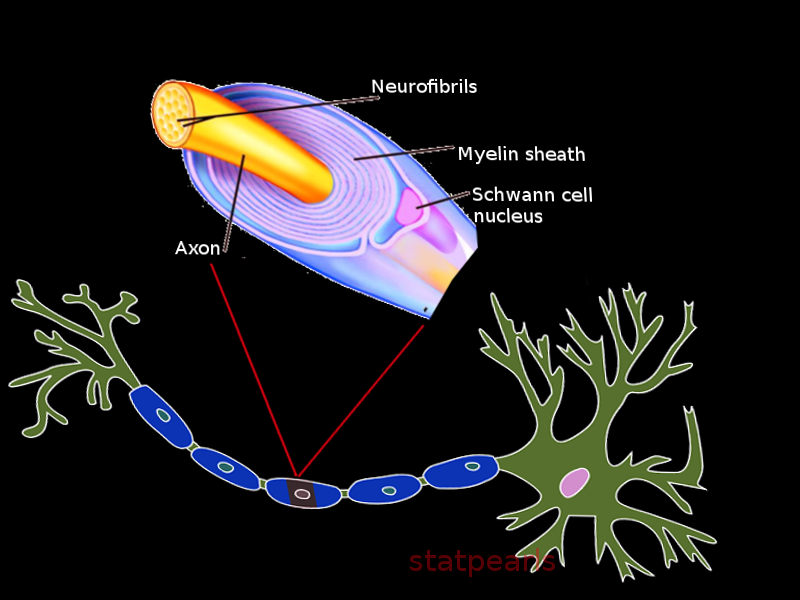[1]
Salzer JL. Clustering sodium channels at the node of Ranvier: close encounters of the axon-glia kind. Neuron. 1997 Jun:18(6):843-6
[PubMed PMID: 9208851]
[2]
Small JR, Ghabriel MN, Allt G. The development of Schmidt-Lanterman incisures: an electron microscope study. Journal of anatomy. 1987 Feb:150():277-86
[PubMed PMID: 3654340]
[3]
Ghabriel MN, Allt G. The role of Schmidt-Lanterman incisures in Wallerian degeneration. I. A quantitative teased fibre study. Acta neuropathologica. 1979 Nov:48(2):93-93
[PubMed PMID: 506700]
[4]
Nave KA, Werner HB. Myelination of the nervous system: mechanisms and functions. Annual review of cell and developmental biology. 2014:30():503-33. doi: 10.1146/annurev-cellbio-100913-013101. Epub
[PubMed PMID: 25288117]
[5]
Möbius W, Nave KA, Werner HB. Electron microscopy of myelin: Structure preservation by high-pressure freezing. Brain research. 2016 Jun 15:1641(Pt A):92-100. doi: 10.1016/j.brainres.2016.02.027. Epub 2016 Feb 24
[PubMed PMID: 26920467]
[6]
Fix AS, Garman RH. Practical aspects of neuropathology: a technical guide for working with the nervous system. Toxicologic pathology. 2000 Jan-Feb:28(1):122-31
[PubMed PMID: 10668998]
[7]
Mithen FA, Wood PM, Agrawal HC, Bunge RP. Immunohistochemical study of myelin sheaths formed by oligodendrocytes interacting with dissociated dorsal root ganglion neurons in culture. Brain research. 1983 Feb 28:262(1):63-9
[PubMed PMID: 6187412]
[8]
Miko TL, Gschmeissner SE. Histological methods for assessing myelin sheaths and axons in human nerve trunks. Biotechnic & histochemistry : official publication of the Biological Stain Commission. 1994 Mar:69(2):68-77
[PubMed PMID: 8204769]
[9]
Daumas-Duport C, Scheithauer BW, Kelly PJ. A histologic and cytologic method for the spatial definition of gliomas. Mayo Clinic proceedings. 1987 Jun:62(6):435-49
[PubMed PMID: 2437411]
[10]
Giacci MK, Bartlett CA, Huynh M, Kilburn MR, Dunlop SA, Fitzgerald M. Three dimensional electron microscopy reveals changing axonal and myelin morphology along normal and partially injured optic nerves. Scientific reports. 2018 Mar 5:8(1):3979. doi: 10.1038/s41598-018-22361-2. Epub 2018 Mar 5
[PubMed PMID: 29507421]
[11]
Compston A, Coles A. Multiple sclerosis. Lancet (London, England). 2008 Oct 25:372(9648):1502-17. doi: 10.1016/S0140-6736(08)61620-7. Epub
[PubMed PMID: 18970977]
[12]
Anderson DW, Ellenberg JH, Leventhal CM, Reingold SC, Rodriguez M, Silberberg DH. Revised estimate of the prevalence of multiple sclerosis in the United States. Annals of neurology. 1992 Mar:31(3):333-6
[PubMed PMID: 1637140]
[13]
. Fact sheet on Guillain-Barré syndrome (updated October 2016. Releve epidemiologique hebdomadaire. 2017 Feb 3:92(5):50-2
[PubMed PMID: 28155266]
[14]
Sharpe RJ. The low incidence of multiple sclerosis in areas near the equator may be due to ultraviolet light induced suppressor cells to melanocyte antigens. Medical hypotheses. 1986 Apr:19(4):319-23
[PubMed PMID: 2940440]
[15]
Levitt P, Veenstra-VanderWeele J. Neurodevelopment and the origins of brain disorders. Neuropsychopharmacology : official publication of the American College of Neuropsychopharmacology. 2015 Jan:40(1):1-3. doi: 10.1038/npp.2014.237. Epub
[PubMed PMID: 25482168]
[16]
Barateiro A, Brites D, Fernandes A. Oligodendrocyte Development and Myelination in Neurodevelopment: Molecular Mechanisms in Health and Disease. Current pharmaceutical design. 2016:22(6):656-79
[PubMed PMID: 26635271]
[17]
Jacobs LD, Cookfair DL, Rudick RA, Herndon RM, Richert JR, Salazar AM, Fischer JS, Goodkin DE, Granger CV, Simon JH, Alam JJ, Bartoszak DM, Bourdette DN, Braiman J, Brownscheidle CM, Coats ME, Cohan SL, Dougherty DS, Kinkel RP, Mass MK, Munschauer FE 3rd, Priore RL, Pullicino PM, Scherokman BJ, Whitham RH. Intramuscular interferon beta-1a for disease progression in relapsing multiple sclerosis. The Multiple Sclerosis Collaborative Research Group (MSCRG). Annals of neurology. 1996 Mar:39(3):285-94
[PubMed PMID: 8602746]
[18]
Verboon C, van Doorn PA, Jacobs BC. Treatment dilemmas in Guillain-Barré syndrome. Journal of neurology, neurosurgery, and psychiatry. 2017 Apr:88(4):346-352. doi: 10.1136/jnnp-2016-314862. Epub 2016 Nov 11
[PubMed PMID: 27837102]

